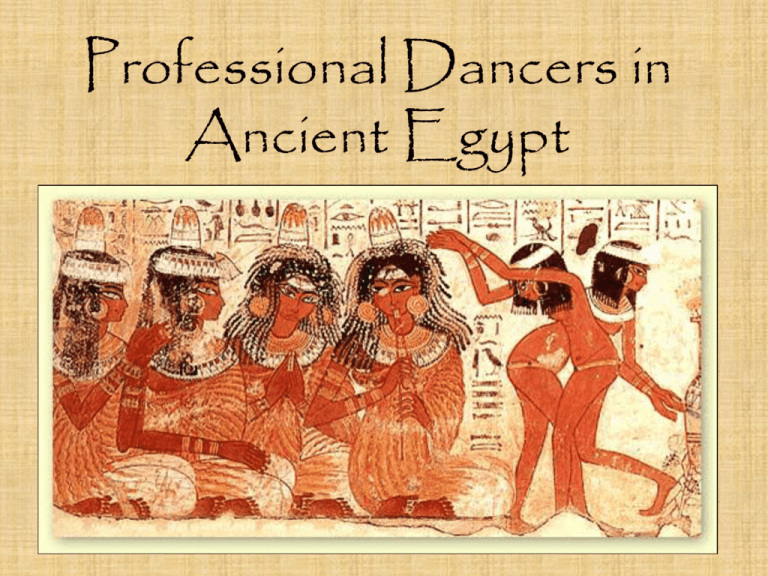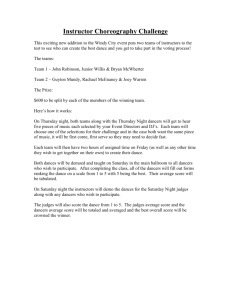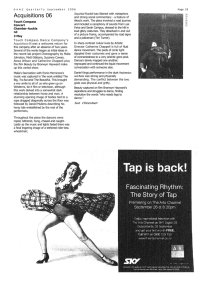Professional Dancers in Ancient Egypt
advertisement

Professional Dancers in Ancient Egypt Some research issues Time span: from Predynastic to Greco-Roman Period •Predynastic: through ca. 2524 BCE •Old Kingdom: ca. 2524-2260 BCE (Interregnum) •Middle Kingdom: ca. 2134-1784 BCE •New Kingdom: ca. 1570-945 BCE •Ptolomaic/Roman domination: 332 BCE into 4th century CE This includes several periods of invasion and population change Some research issues Evidence varies – different sorts of evidence from different periods Interpretation of types of evidence is uncertain (especially artistic evidence) Assumptions underlying texts and illustrations may be different from ours Most work on Egyptian dance was done in the early 20th century and needs revision. Some questions •Who were the professional dancers and what was their social status? •High society vs. ordinary people – very few records of ordinary people •What sort of dancing did professional dancers do? •Role of dancing within the culture •What constitutes “professional” – is it always (or ever) a valid category within the culture? •Musicians and Instrumentation and their reflection on dance Is it Belly Dance? If it is, it will be (1) Soloimprovised and (2) Based on hip and torso articulation. Look for: •Costuming emphasizing hips? •Crotala? •Celebratory occasions? •Dancers engaged in different movements? •Vocabulary associated with hip articulation? Contexts •Sacred occasions: temple positions and rituals, funeral rituals, both depicted and described •Secular events: depicted and described •Overlap of sacred and secular •Idealization of both in tomb paintings Predynastic Egypt 3800-3500 BCE Predynastic Egypt Predynastic Egypt Solo female dancers? Barque = sacred occasion or festival? Significance of male figures? Predynastic Egypt An Old Kingdom example of raised arms as a convention for dance Acrobatic Dancers Depiction of Acrobatic dancers from the Red Chapel at Karnak, receptacle of the barque of Amon. Context: Celebration of Amon, journey of the barque Acrobatic Dancers •Level of skill may indicate professional training •What status of women does this imply? Aristocratic women? •Women attached permanently to temples for dance and other services? Acrobatic Dancers An old kingdom tomb painting (l) and a shard of pottery (below). These positions occur elsewhere too. What do they show about dance? Can we interpret either the action they show or their meaning? Acrobatic Dancers Related positions in the depiction of acrobatic(?) dance. Interpretation? The hnr The hnr was a group of musicians and dancers who provided services for both cult and non-cult activities. Old kingdom hnr seemed mostly women; later men are attested as well. Singers who “daily rejoice the heart of the king with beautiful songs …”- Choreographies? In many instances unity rather than spontaneity is emphasized Status “There is no evidence that female musicians in Egypt were thought to be of disreputable character. . . The indication of status that is associated with musicians is also indicated by the presence of many women of the upper classes and the royal family who served as musicians in temples as well as in the royal residence.” Emily Teeter, “Female Musicians in Egypt.” Status Throughout Egyptian history, women of high status are depicted as musicians. No similar depictions as dancers. Women musicians may have achieved “star” status: musicians’ names preserved in hieroglyphic “labels.” Not so dancers. Is this a real difference in status? Status Some dancers are shown nude. Is nudity a status determinative in art? Probably not, as nudity is shown in many situations, including even highstatus women. Here 3 musicians are shown in varying states, presumably without status differentiation Status Music and dance both evoke sensuality and pleasures for the taking – are women excluded as consumers of pleasure, and depicted only as providers for men? Or are women’s roles in creating celebratory atmospheres respected and counted as a positive element overall? Redjedet The story of Redjedet explains the birth of the three first rulers of the fifth dynasty. Ra sends three goddesses (Isis, Hathor and Nephthys) to oversee the birth, impersonating a group of dancer/ musicians. tomb of Akhenaton So these gods set out and they made their appearance as that of musicians, while Khnum was with them as porter. When they arrived at the home of Userre, they found him standing, (his) loin cloth upside down. Redjedet They held out their menat and sistra and he said to them: "My wife, behold, she is a woman suffering from labour pains". They said: "Let us see her, for behold, we know about child bearing". Redjedet And he said to them: "Proceed". They entered to Redjedet, locking the room behind her and themselves. Isis placed herself before her, Nephthys behind her and Heqet hastened the birth. This child rushed forth onto her arms, a child of one cubit (in length), strong of bones, his limbs covered with gold and his headdress of true lapis lazuli. Redjedet These gods came out, having delivered Redjedet from child birth and they said: "May your heart rejoice, Userre, for three children are born to you". And he said to them: "My ladies, what can I do for you? Please, give this sack of barley to your porter and take it in exchange for some beer". Khnum loaded himself with the sack of barley and then they went back to the place whence they came. Redjedet ... The maidservent went down but when she opened the room, she heard the sound of singing, music, dancing, shouting and everything that is done for a king in the room. She went and she repeated all that she heard to Reddjedet. She the walked around in the room, but she did not find the place where it was done. Solo-Improvised Dance Do we find the equivalent of “belly dancing”? What is “belly dancing” Folk form of “solo-improvised dance based on torso articulation,” as performed by dancers for audiences Can we find solo-improvised dance, and if so, determine the technique used? Solo-Improvised Dance All the people of all the dwellings of the court heard (of the coronation of Hatshepsut); they came, their mouths rejoicing, they proclaimed (it) beyond everything, dwelling on dwelling therein was announcing (it) in his name; soldiers on soldiers [...], they leaped and they danced for the double joy in their hearts. James Henry Breasted Ancient Records of Egypt, Part Two, § 238 Solo-Improvised Dance Some Greek Evidence ... the rest of the feast of Dionysos is celebrated by the Egyptians in the same way as by the Hellenes in almost all things except choral dances.... Herodotus, Histories II ... They sail, men and women together, and a great multitude of each sex in every boat; and some of the women have rattles and rattle with them, while some of the men play the flute during the whole time of the voyage, and the rest, both women and men, sing and clap their hands; and when as they sail they come opposite to any city on the way they bring the boat to land, and some of the women continue to do as I have said, others cry aloud and jeer at the women in that city, some dance, and some stand up and pull up their garments. Herodotus, Histories II Solo-Improvised Dance … Come northward to the court immediately; [...] thou shalt bring this dwarf with thee, which thou bringest living, prosperous and healthy from the land of spirits, for the dances of the god, to rejoice and gladden the heart of the king of Upper and Lower Egypt, Neferkere, who lives forever. From the letter of Pepi II to Harkhuf James Henry Breasted Ancient Records of Egypt, Part One, § 353 Solo-Improvised Dance What are the possible conventions of showing this sort of dance? Solo-Improvised Dance Solo-Improvised Dance Solo-Improvised Dance 1405-1395 BCE tomb of Djeserkareseneb Solo-Improvised Dance Solo-Improvised Dance Some Roman Evidence Solo-Improvised Dance Some Roman Evidence Because it is meant to show cultural difference, this image is valuable in indicating hip articulation and solo improvisation in the dance style of Egypt. Solo-Improvised Dance Some Roman Evidence The scene depicted is probably the Apis festival. Is this a formal event or popular dancing? That is unclear since the iconography is unconventional. Solo-Improvised Dance Some Roman Evidence •Women are shown as the main dancers, while the men clap in accompaniment or play percussion (?) •Is this a real perception, or Roman prejudice? Musical Accompaniment Flutes, cymbals, and drums survive Music may have been more like Nubian music today in rhythm and sound How persistent is musical style? Musical Accompaniment Percussion is a key element of depictions of dance: rhythmic clapping by women, or frame drums played usually by women. Cymbals and various forms of crotala survive Musical Accompaniment Musical Accompaniment Here women play lute-like instruments ... Musical Accompaniment Various forms of lyre are depicted. Professional musicians, or skilled amateurs? Or is “professional” the right concept? Musical Accompaniment Several types of reed flutes are played here. Instruments include flutes and reed-mouthpiece instruments. Greco-Roman Egypt Issues: Greek, Roman and native Egyptian population mix Detailed information about prices, social organization, etc. Still little information about the type of dancing Possible insight on lifestyle of dancers Greco-Roman Egypt What are these veiled dancers doing? •Ordinary women dancing in processions? •Professional dancers doing a set dance? •Women casting off inhibition? •A dance, or a moment in a religious experience? Greco-Roman Egypt Greco-Roman Egypt Contract with Isidora To Isidora, krotalistria, from Artemisia of the village of Philadelphia. I request that you, assisted by another krotalistria, total two, undertake to perform at the festival at my house for six days beginning with the 25th of the month Payni according to the old calendar, and you two to receive as pay 36 drachmas for each day, and we to furnish in addition 4 artabas of barley … Contract with Isidora …and 24 pairs of bread loaves, and on condition further that, if garments or gold ornaments are brought down, we will guard these safely, and that we will furnish you with two donkeys when you come down, and a like number when you go back to the city. Year 14 of Lucius Septimius Severus Pius Pertinax … (206 CE) Greco-Roman Egypt •Isidora as independent business-woman •Works with other dancers on a loose basis – is she a “booking agent” as well as a dancer? •A woman hires them on behalf of the community – a wealthy woman performing a “liturgy”? Greco-Roman Egypt Contract with Isidora •Usually a “binding fee” is set in advance •Dancers are expected to have fine costumes and jewelry (portable wealth and display) •Style of dance? •Dancers vs. prostitutes – Greek vs. Egyptian? Greco-Roman Egypt •Pay is well above the rate for other labor – days working is an issue though – •Board and transportation provided in a standard contract Greco-Roman Egypt •Other contracts: day rates for musicians similar to other laborers – was Isidora a “star”? •How often did a working dancer work? •What about her musical accompaniment? None mentioned in the contract ... Greco-Roman Egypt Hiring Zenobios Demophon to Ptolemaios, greetings. By all means send me the flute-player Petous with both the Phrygian and other flutes; and if any expenditure is necessary, pay it and you will be reimbursed by me. Send me also Zenobios the effeminate dancer [kinaidos] with the drum and cymbals and castanets, for the women want him for the sacrifice; and let him be dressed as elegantly as possible. Get the kid from Aristion and send it to me. And you have arrested the slave, hand him over to Semphtheus to bring to me. Send me also as many cheeses as you can, empty jars, vegetables of every sort, and whatever delicacies you have. Farewell. Put them on board with the policemen who will help to bring the boat along. finis





